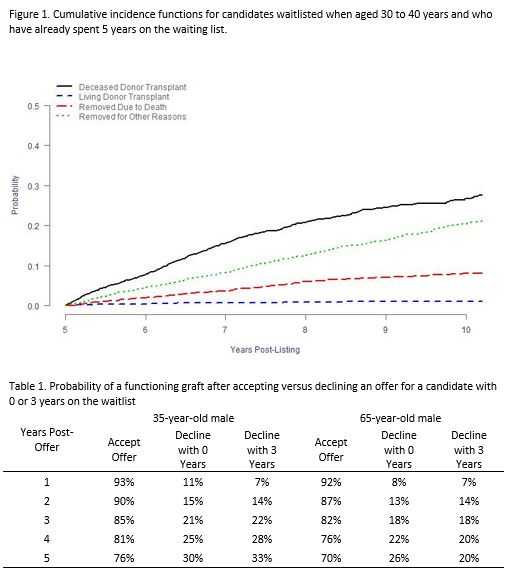Accepting a High-KDPI Kidney versus Waiting for Another Offer Can Improve Chances of a Functioning Graft.
1Scientific Registry of Transplant Recipients, Minneapolis, MN
2Mayo Clinic, Rochester, MN
Meeting: 2017 American Transplant Congress
Abstract number: A102
Keywords: Donors, Graft survival, Kidney, marginal, Procurement
Session Information
Session Name: Poster Session A: Deceased Donor Issues I: Allocation, KDPI and Recipient Selection
Session Type: Poster Session
Date: Saturday, April 29, 2017
Session Time: 5:30pm-7:30pm
 Presentation Time: 5:30pm-7:30pm
Presentation Time: 5:30pm-7:30pm
Location: Hall D1
Less than 50% of waitlisted candidates undergo a first deceased donor transplant within 5 years. Yet approximately 20% of recovered kidneys and >50% of kidneys with high donor risk (kidney donor profile index [KDPI] >85%) are discarded. We therefore investigated the tradeoff between transplanting a high-KDPI kidney versus the risk of waiting for a better kidney. Specifically, we estimate the probability of a functioning kidney graft in 1 to 5 years from the time of offer of a deceased donor kidney with KDPI = 95% and an expected 30 hours of cold ischemia time. If the offer is accepted, the probability of a functioning graft is derived from the estimated posttransplant graft survival curve. Otherwise, the probability of a functioning graft is a product of the probability of a living or deceased donor transplant and posttransplant graft survival on each day over the next 1 to 5 years. Posttransplant graft survival was estimated with first kidney-alone recipients between May 1, 2007, and June 30, 2015, adjusted for candidate and donor risk factors. The probabilities of a living or deceased donor transplant were estimated with cumulative incidence functions with the period prevalent cohort of first kidney-alone candidates on the list between January 1, 2013, and December 31, 2014. Figure 1 presents the cumulative incidence for candidates waitlisted when aged 30 to 40 years and who had already spent 5 years on the waiting list. Despite relatively high priority, these candidates are unlikely to undergo transplant after an additional 5 years on the waiting list. Due to the low likelihood of transplant, Table 1 shows that accepting a high-KDPI offer can maximize the probability of graft function for young and old patients. While donor quality is strongly associated with posttransplant graft survival, due to the severe shortage of deceased donor kidneys, even high-risk kidneys provide potential benefit to patients compared with declining the offer and remaining on the list.
CITATION INFORMATION: Wey A, Salkowski N, Kremers W, Israni A, Kasiske B, Snyder J. Accepting a High-KDPI Kidney versus Waiting for Another Offer Can Improve Chances of a Functioning Graft. Am J Transplant. 2017;17 (suppl 3).
To cite this abstract in AMA style:
Wey A, Salkowski N, Kremers W, Israni A, Kasiske B, Snyder J. Accepting a High-KDPI Kidney versus Waiting for Another Offer Can Improve Chances of a Functioning Graft. [abstract]. Am J Transplant. 2017; 17 (suppl 3). https://atcmeetingabstracts.com/abstract/accepting-a-high-kdpi-kidney-versus-waiting-for-another-offer-can-improve-chances-of-a-functioning-graft/. Accessed December 13, 2025.« Back to 2017 American Transplant Congress
